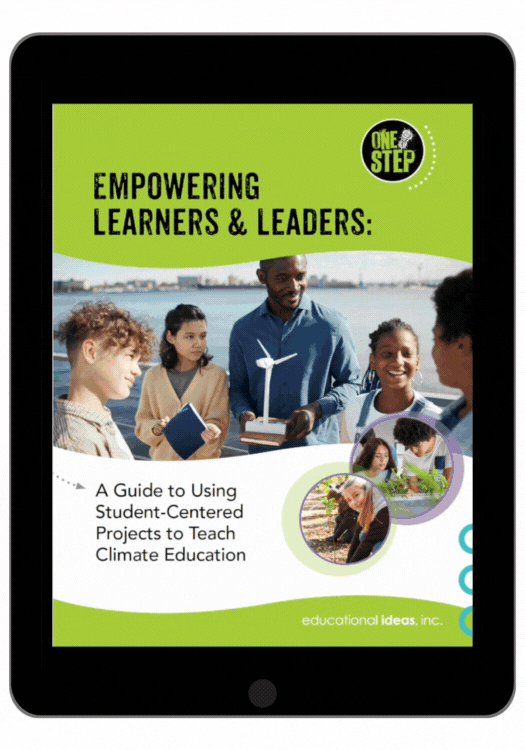
“Live simply, so others may simply live.”
– Mahatma Gandhi
Amidst a world cluttered with stuff and distractions, mindful minimalism offers an empowering solution. The philosophy is more than just tidying up our physical space; it’s about finding peace of mind and purpose by letting go of what we don’t need or no longer serves us.
For young people feeling overwhelmed by the challenges of the world, including climate change, mindful minimalism can be a game-changer. Teachers can help students embrace this mindset, freeing them from stress and distraction so they can focus on what truly matters: their growth and future success.
Share these practical tips with students and colleagues to help them live simpler, more intentional lives and make a positive impact on the world around them.
Physical Minimalism:
“The end goal is not a tidy home. The end goal is a fundamental shift in one’s relationship with possessions. Perhaps the biggest benefit to supporting your local economy is that it strengthens community resilience, a necessity for combatting future challenges associated with climate change.”
― Stephanie Marie Seferian, Author
- Clear the clutter from your living space by donating or discarding items you no longer need.
- Re-think your wardrobe and invest in a limited number of versatile clothing items you love and wear frequently.
- Simplify your diet by focusing on whole, unprocessed foods and reducing unnecessary kitchen appliances or utensils.
- Embrace zero-waste by minimizing single-use plastics and opting for reusable alternatives like water bottles, food containers, and shopping bags.
- Be a conscious consumer by considering the environmental and ethical impact of products before making a purchase. Buying locally also stimulates your local economy and strengthens community bonds.
- Choose quality over quantity by investing in durable, longer-lasting items versus disposable or cheaply made products that end up in landfills.
- Compost organic waste to divert it from landfills and enrich soil health.
- Cut carbon emissions and opt to walk, cycle, or utilize public transportation whenever possible or carpool/rideshare to minimize the environmental impact of personal vehicle use.
- Adopt a plant-based diet or reduce meat consumption to lower your carbon footprint associated with animal agriculture. (Supporting local farmers and purchasing seasonal produce also reduces the environmental impact of food transportation).
Mental & Emotional Minimalism:
“Mental clarity brings about emotional stability and purposeful action.”
– Deepak Chopra
- Practice mindfulness, goal setting, or meditation to declutter your mind and cultivate inner peace and intention. Limiting exposure to negative news and social media can also work to reduce mental clutter and anxiety.
- Prioritize tasks and commitments to avoid feeling overwhelmed or mentally fatigued.
- Set boundaries in your personal and professional relationships in order to help you prioritize your emotional well-being and avoid emotional clutter.
- Let go of grudges or resentments that will work to free you from negative emotional attachments.
- Cultivate gratitude and focus on positive experiences to shift your emotional perspective toward abundance rather than lack.
Adopting a mindful minimalism philosophy also cultivates intentionality, aiding in setting meaningful goals that resonate with values and aspirations. We can make deliberate choices about shaping the future through presence and awareness. Psychologists also note benefits that include an increased mood, better focus and productivity, and a greater sense of well-being.
By embracing mindfulness, individuals, and young people, can navigate the challenges of the state of the world and climate change with greater resilience.
Empowering Learners & Leaders: A Guide to Using Student-Centered Projects to Teach Climate Education
 Download our playbook full of strategies, resources, and project ideas that empower students and reduce their climate anxiety.
Download our playbook full of strategies, resources, and project ideas that empower students and reduce their climate anxiety.
Inside, you’ll discover:
- Five student-led, solution-focused projects that will inspire and engage middle and high school students
- Resources to ignite student learning, engagement, and action in your school or district
- Examples of real-world student-led green initiatives
- And more!
Try a Solutions-Based Approach to Climate Education
One Step is a video-based climate science curriculum for grades 4–12 that takes students on a journey across the globe. They’ll explore green solutions and technologies that address the challenges of climate change, empowering them to be learners, leaders, and changemakers.
Invite Teachers to Try One Step Free for 30 Days!



